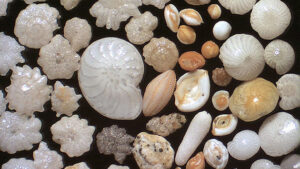Scientists Improve Climate Predictions Using Tiny Marine Organisms

For researchers interested in the global climate system, understanding what the future holds often involves studying the climate of the past—a scientific field called paleoclimatology. To understand what Earth’s climate was like thousands, even millions, of years ago, paleoclimatologists rely on preserved physical evidence of climate information, such as tree rings, ice cores, and even the shells of marine microorganisms.
One such microorganism is the foraminifera: a class of protists, usually less than 1mm in size, that commonly live on the seafloor. The shells of foraminifera are often composed of calcium carbonate (CaCO3), which provides a record of the oxygen isotopic composition of the water and the temperature when the foraminifera were alive. By studying the composition of oxygen isotopes in these shells, scientists can gain insight into what climate conditions were like when they were first formed.
Scientists have long known that oxygen isotopes are taken up in the shells in different ratios at different temperatures. However, there is still uncertainty about how to best use temperature measurements and inorganic data (from the foraminifera) to reconstruct climate conditions. In a recent paper published in Geochimica et Cosmochimica Acta, a group of researchers led by T.M. Marchitto (University of Colorado, Boulder), and including BIOS Director Bill Curry, developed improved temperature calibrations using benthic foraminifera.
The researchers studied five species of foraminifera collected in core samples from 31 sites in the Florida Straits, as well as one species collected from 27 sites in the Pacific sector of the Arctic Ocean. By combining oxygen isotope measurements with salinity, pH, and temperature data—as well as previously published data—they were able to develop more accurate equations for determining oxygen isotope fractionation as a function of temperature.
Oxygen isotope measurements from foraminifera are standard components of modern paleoceanographic studies, and obtaining improved calibrations between temperature and oxygen isotopes will allow scientists to more accurately reconstruct upper ocean temperatures and past climate conditions.
